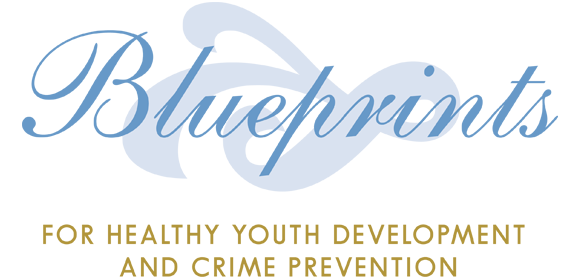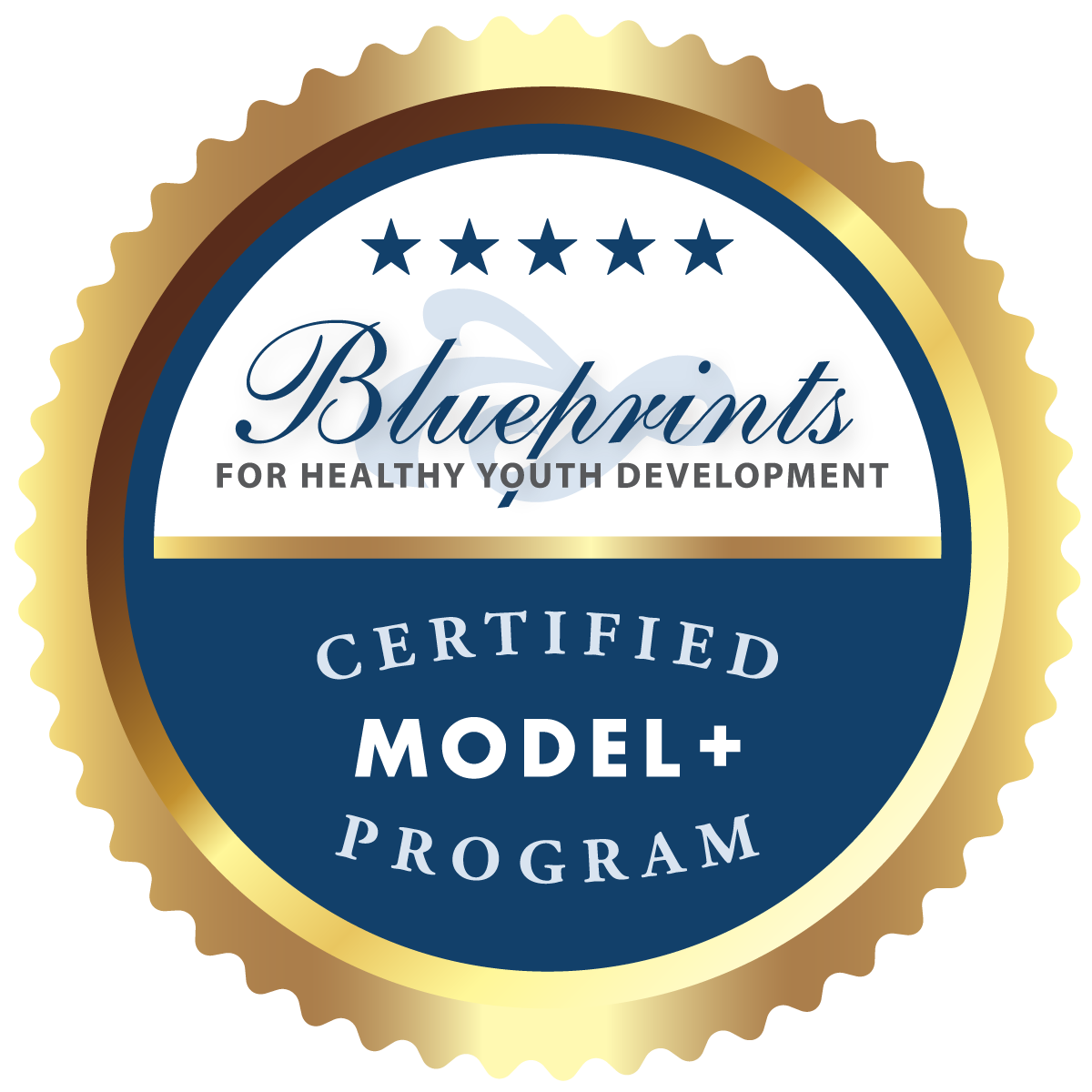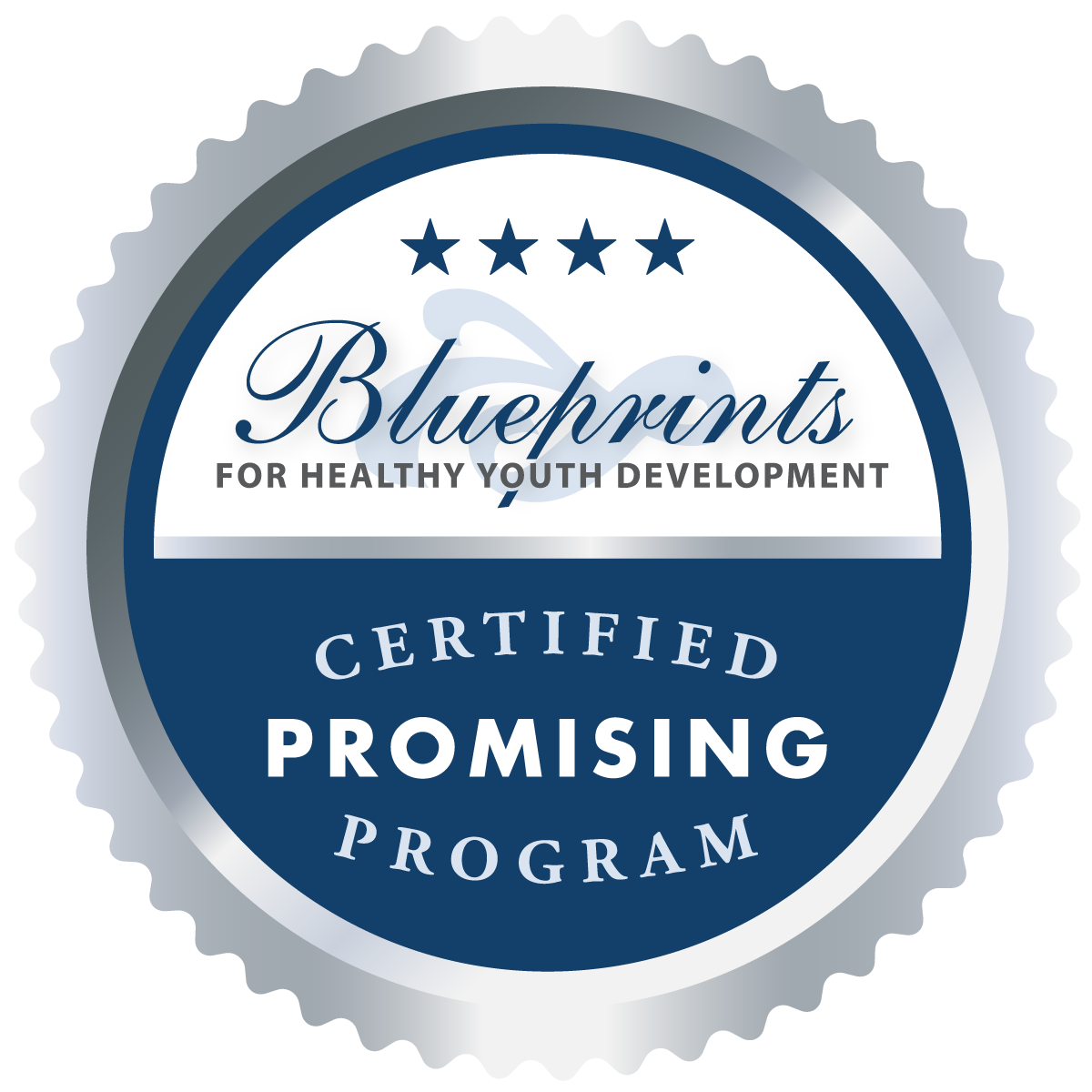
Program Search
This interactive search enables you to identify Blueprints-certified interventions based on specific criteria and then browse through a wide range of interventions that match those criteria. Select only a few criteria of importance, as the number of interventions may be reduced by selecting multiple items ACROSS categories, or increased by selecting multiple items WITHIN categories.
Model and Model Plus programs are listed separately from Promising programs. This is because only Model and Model Plus programs have demonstrated efficacy for changing outcomes over time and are recommended for large-scale implementation. Promising programs show promise of efficacy, but require follow-up research before being recommended for large-scale adoption.
18 Programs
| Program | Rating | Summary |
|---|---|---|
|
GenerationPMTO
|
 Model Plus
Model Plus
|
A family training program that aims to teach effective family management skills in order to reduce antisocial and problematic behavior in children through trainings implemented in a variety of formats and settings.
A family training program that aims to teach effective family management skills in order to reduce antisocial and problematic behavior in children through trainings implemented in a variety of formats and settings.
|
Target Population
Age: Early Childhood (3-4) - Preschool, Late Adolescence (15-18) - High School, Early Adolescence (12-14) - Middle School, Late Childhood (5-11) - K/Elementary |
||
|
Family Check-Up - Early Childhood
|
 Model
Model
|
A parent training program that aims to prevent conduct problems among at-risk young children by improving the quality of parenting and increasing and maintaining parents' use of positive behavior support. A parent training program that aims to prevent conduct problems among at-risk young children by improving the quality of parenting and increasing and maintaining parents' use of positive behavior support. |
Target Population
Age: Early Childhood (3-4) - Preschool, Infant (0-2), Late Childhood (5-11) - K/Elementary |
||
|
ParentCorps
|
 Model
Model
|
A multi-level intervention designed for pre-kindergarten children living in low-income neighborhoods to create safe, nurturing and predictable environments at home and in the classroom and improve relationships and communication between parents and teachers.
A multi-level intervention designed for pre-kindergarten children living in low-income neighborhoods to create safe, nurturing and predictable environments at home and in the classroom and improve relationships and communication between parents and teachers.
|
Target Population
Age: Early Childhood (3-4) - Preschool |
||
| Program | Rating | Summary |
|---|---|---|
|
Child First
|
 Promising
Promising
|
A two-generation home visitation program which works to heal and protect young children and their families from the devastating effects of chronic stress and trauma. It provides psycho-therapeutic services and intensive care coordination, while building adult reflective and executive capacity, to prevent or diminish serious emotional disturbance, developmental and learning disabilities, and abuse and neglect among young children.
A two-generation home visitation program which works to heal and protect young children and their families from the devastating effects of chronic stress and trauma. It provides psycho-therapeutic services and intensive care coordination, while building adult reflective and executive capacity, to prevent or diminish serious emotional disturbance, developmental and learning disabilities, and abuse and neglect among young children.
|
Target Population
Age: Early Childhood (3-4) - Preschool, Infant (0-2) |
||
|
Communities That Care
|
 Promising
Promising
|
A prevention system designed to reduce levels of adolescent delinquency and substance use through the selection and use of effective preventative interventions tailored to a community's specific profile of risk and protection.
A prevention system designed to reduce levels of adolescent delinquency and substance use through the selection and use of effective preventative interventions tailored to a community's specific profile of risk and protection.
|
Target Population
Age: Early Childhood (3-4) - Preschool, Infant (0-2), Early Adulthood (19-24), Late Adolescence (15-18) - High School, Early Adolescence (12-14) - Middle School, Late Childhood (5-11) - K/Elementary |
||
|
Coping Power Universal for Preschoolers
|
 Promising
Promising
|
A school-based prevention program that aims to reduce problem behaviors and promote social competence in preschoolers through a curriculum delivered by teachers in the regular classroom setting. A school-based prevention program that aims to reduce problem behaviors and promote social competence in preschoolers through a curriculum delivered by teachers in the regular classroom setting. |
Target Population
Age: Early Childhood (3-4) - Preschool |
||
|
Early Literacy and Learning Model
|
 Promising
Promising
|
A literacy-focused curriculum and support system designed for preschool children ages 3, 4, and 5 years old. The program is designed to enhance existing classroom curricula by specifically focusing on improving children's early literacy skills and knowledge.
A literacy-focused curriculum and support system designed for preschool children ages 3, 4, and 5 years old. The program is designed to enhance existing classroom curricula by specifically focusing on improving children's early literacy skills and knowledge.
|
Target Population
Age: Early Childhood (3-4) - Preschool |
||
|
Head Start REDI
|
 Promising
Promising
|
An enrichment program for low-income preschoolers and their families that supplements the Head Start preschool program.
An enrichment program for low-income preschoolers and their families that supplements the Head Start preschool program.
|
Target Population
Age: Early Childhood (3-4) - Preschool |
||
|
HighScope Preschool
|
 Promising
Promising
|
A preschool program that builds cognitive skills and attitudes for school success and aims to prevent adolescent delinquency and school dropout in the long term.
A preschool program that builds cognitive skills and attitudes for school success and aims to prevent adolescent delinquency and school dropout in the long term.
|
Target Population
Age: Early Childhood (3-4) - Preschool |
||
|
Incredible Years - Child Treatment
|
 Promising
Promising
|
A child treatment program used by counselors and therapists in a small group setting to treat children ages 4-8 years with conduct problems, ADHD, and internalizing problems by enhancing social competence, positive peer interactions, conflict management strategies, emotional literacy, and anger management. The small group treatment program is delivered in 18-22 weekly 2-hour sessions. A child treatment program used by counselors and therapists in a small group setting to treat children ages 4-8 years with conduct problems, ADHD, and internalizing problems by enhancing social competence, positive peer interactions, conflict management strategies, emotional literacy, and anger management. The small group treatment program is delivered in 18-22 weekly 2-hour sessions. |
Target Population
Age: Early Childhood (3-4) - Preschool, Late Childhood (5-11) - K/Elementary |
||
|
Incredible Years - Parent
|
 Promising
Promising
|
A group-based parenting program delivered in weekly sessions over 3-5 months that strengthens parent competencies to promote young children's social, emotional, and academic competence and prevent the development of conduct problems.
A group-based parenting program delivered in weekly sessions over 3-5 months that strengthens parent competencies to promote young children's social, emotional, and academic competence and prevent the development of conduct problems.
|
Target Population
Age: Early Childhood (3-4) - Preschool, Late Childhood (5-11) - K/Elementary |
||
|
Incredible Years - Teacher Classroom Management
|
 Promising
Promising
|
A program that provides teachers of children ages 3-8 years with classroom management strategies (positive and proactive teaching techniques, positive teacher-student relationships, and supportive teacher-parent relationships) to manage difficult and inappropriate child behavior problems, while promoting social, emotional, and academic competence.
A program that provides teachers of children ages 3-8 years with classroom management strategies (positive and proactive teaching techniques, positive teacher-student relationships, and supportive teacher-parent relationships) to manage difficult and inappropriate child behavior problems, while promoting social, emotional, and academic competence.
|
Target Population
Age: Early Childhood (3-4) - Preschool, Late Childhood (5-11) - K/Elementary |
||
|
Nuffield Early Language Intervention
|
 Promising
Promising
|
A school-based program designed to improve children's vocabulary, narrative skills, active listening, and confidence in independent speaking.
A school-based program designed to improve children's vocabulary, narrative skills, active listening, and confidence in independent speaking.
|
Target Population
Age: Early Childhood (3-4) - Preschool, Late Childhood (5-11) - K/Elementary |
||
|
Parent-Child Interaction Therapy
|
 Promising
Promising
|
A program designed for children and their parents that focuses on decreasing child behavior problems, increasing positive parent behaviors, and improving the quality of the parent-child relationship.
A program designed for children and their parents that focuses on decreasing child behavior problems, increasing positive parent behaviors, and improving the quality of the parent-child relationship.
|
Target Population
Age: Early Childhood (3-4) - Preschool, Late Childhood (5-11) - K/Elementary |
||
|
Red Light, Purple Light!: A Self-Regulation Intervention
|
 Promising
Promising
|
A preschool-based program intended to improve behavioral aspects of self-regulation in children through circle time music and movement games that target attention, working memory, and inhibitory control. A preschool-based program intended to improve behavioral aspects of self-regulation in children through circle time music and movement games that target attention, working memory, and inhibitory control. |
Target Population
Age: Early Childhood (3-4) - Preschool |
||
|
Story Talk - Interactive Book Reading Program
|
 Promising
Promising
|
A reading strategy intended to promote the development of language and literacy skills in young children from low-income families.
A reading strategy intended to promote the development of language and literacy skills in young children from low-income families.
|
Target Population
Age: Early Childhood (3-4) - Preschool |
||
|
Tools of the Mind
|
 Promising
Promising
|
An Early Childhood (preschool and kindergarten) program designed to promote academic learning and prosocial behaviors by supporting the development of executive function and other regulation-related skills. An Early Childhood (preschool and kindergarten) program designed to promote academic learning and prosocial behaviors by supporting the development of executive function and other regulation-related skills. |
Target Population
Age: Early Childhood (3-4) - Preschool, Late Childhood (5-11) - K/Elementary |
||
|
Triple P System
|
 Promising
Promising
|
A public health approach to reach all parents in a community to enhance parental competence and prevent or alter dysfunctional parenting practices, thereby reducing family risk factors both for child maltreatment and for children's behavioral and emotional problems.
A public health approach to reach all parents in a community to enhance parental competence and prevent or alter dysfunctional parenting practices, thereby reducing family risk factors both for child maltreatment and for children's behavioral and emotional problems.
|
Target Population
Age: Early Childhood (3-4) - Preschool, Infant (0-2), Adult, Late Childhood (5-11) - K/Elementary |
||
 Program
Program